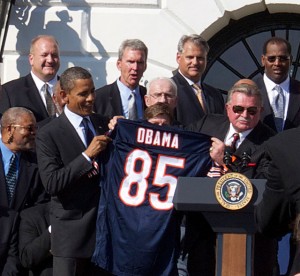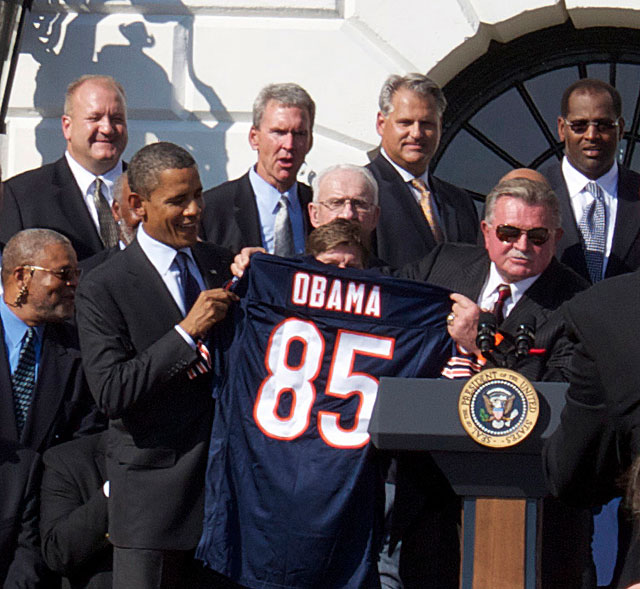In 1980, a torn ACL could end a professional athlete’s career. Today, minor surgery and proper rehabilitation can get a player back on his feet before the season’s end. In 1980, an on-field brain injury could be overlooked. Today, a hit to the head can sideline a player for weeks as he recovers from a concussion.

“This is as much fun as I will have as President of the United States,” Obama said, calling the team the greatest in NFL history. Photo by Sara J. Martinez/MNS
The 1985 Chicago Bears, a team known for its hard hits and merciless nature, were welcomed to the White House for the 25th anniversary of their Super Bowl XX victory last week. In the years since the team’s glory days, not much has changed in the game or the injuries players suffer, but the treatment of football injuries has evolved considerably.
The development of arthroscopy and the recognition of the long-term consequences of repeated concussions have morphed the field of sports medicine into a well-organized, scientific specialty.
With better technology came enhanced diagnostic capabilities and more attention to detail over time. Physicians and trainers now approach the contact sport with an overly cautious attitude to make sure football remains fair, fun and safe.
Few athletes will escape a football field without a few sprains and pains. Rips, tears and breaks can take players out of the game for weeks or months but are generally not career-ending, as they may have been just a couple of decades ago.
Diagnosis and treatment
One of the biggest breakthroughs in sports medicine over the past 30 years is the development of arthroscopic surgery, according to Dr. Gordon Nuber, an orthopaedic surgeon who has been a team physician for the Chicago Bears since 1992.
“Minimally invasive surgery made a huge difference in our understanding of pathology and our ability to repair things that we would not have been able to imagine 25 or 30 years ago,” he said.
Through a small incision, arthroscopy gives surgeons more access to look all around the joints and to fix the torn structure while damaging less soft tissue.
“Back in the 70s and 80s, you’d see these scars that were six inches long across the patient’s knee, and now we can do it through basically a few pokeholes and a one-inch incision,” said Dr. David Geier, director of sports medicine at the Medical University of South Carolina. “Now they get their motion back typically faster, and they get their strength back because you haven’t done as much damage to do the surgery in the first place.”
With the advent of magnetic resonance imaging, doctors can look beyond the bone and more quickly and accurately diagnose injuries.
While the University of Cincinnati has the only facility with an MRI machine, it’s a requirement that X-ray machines are available at all NFL stadiums. There are two at Soldier Field so physicians can evaluate injuries in the locker room.
“Evaluation of these injuries is always getting better, typically when you talk about brain injuries,” Nuber said. “Treatment protocols are getting more and more regimented.”
Concussion detection
Nuber said physicians and trainers at games and practices are much more aware of the severity of concussive injuries.
Repeated hits to the head have been linked to serious health risks including chronic traumatic encephalopathy, a degenerative brain disease with Alzheimer’s-like symptoms. The disease begins to appear several years after the trauma, which does not have to be concussive, and it can only be diagnosed when analyzing a brain posthumously.
“Ten years ago, we knew that professional football players got arthritis and they had joint problems and difficulties like that as they got older,” said Dr. Ann McKee, director of the Center for the Study of Traumatic Encephalopathy at Boston University. “But I don’t think any of us suspected that they had a long-term neurodegenerative disease that was associated with repetitive mild brain trauma.”
The issue is close to home for the Bears. In February, Dave Duerson, a safety with the Bears from 1983 to 1989, shot himself in the chest after requesting his brain be donated to the NFL’s brain bank for testing because he was suspicious he had CTE. After McKee analyzed Duerson’s brain, it was confirmed that the 50-year-old had been suffering from the disease when he took his own life.
“Dave was one of the team’s hardest hitters,” President Barack Obama said when the 1985 Chicago Bears visited the White House. “Hopefully, lessons from his brave struggle with the kind of brain injuries those hits might have caused will help today’s players down the road.”
Dr. Matthew Matava, a team physician for the St. Louis Rams, said that in the past, players may have shaken off concussion symptoms without acknowledging a mild brain injury. Duerson, in fact, was never hospitalized for a concussion.
“Coaches who played back in those days, they’ll say ‘When I was a player back in the 60s or 70s, I didn’t have concussions,’” Matava said. “Now, we’re much more attuned to what symptoms of concussions are, and we’re much more aggressive in treating it.”
Cases like Duerson’s have improved the culture of self-reporting injuries, and it’s no longer taboo to admit to having difficulty concentrating or minor headaches, said Dr. Adam Bennett, who has been a team physician with the Bears for the past seven years.
“In the past, it would have been OK amongst themselves for players to not describe some minor symptoms, but now I think in the clubhouse and locker room, they’re thinking it’s best not to mess with that,” Bennett said. “Football is not more important than your life.”
McKee said that current research points toward ways to diagnose CTE in living individuals within the next few years. There is still no treatment for the disease.
Even with improved diagnostic measures and awareness, along with the development of minimally invasive surgical procedures, contact sports are as dangerous as ever.
“I think the guys are going to get bigger and unfortunately because of increasing size and speed, they are susceptible for more injury,” Nuber said. “But hopefully we’ll have better mechanisms to protect and evaluate them.”
For now, however, the best defense is a good offense – minimizing head contact, wearing appropriate protective equipment, recognizing symptoms and getting proper treatment are the best ways to prevent and mend sports injuries.

